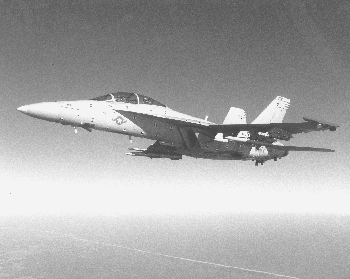
Graham Warwick/WASHINGTON DC
A Blue-Ribbon panel set up to review efforts to cure the Boeing F/A-18E/F wingdrop problem has identified a "national need" to understand the phenomenon.
Concern has been raised by the failure of windtunnel testing and computation fluid-dynamic (CFD) analysis to predict accurately how potential solutions will perform in flight. "This is not unique to the F-18," cautions US Navy programme manager Capt James Godwin. "It is not predictable in the windtunnel, or with CFD. The analytical tools are not available."
The USN is flight-testing two solutions to the wingdrop problem after rejecting remedies which windtunnel testing and CFD analysis indicated would work.
Godwin says that the Blue Ribbon panel believes that "-all aircraft have this [problem]". He reveals that the F-18C/D experiences wingdrop, "but in a different part of the envelope".
The problem is becoming more apparent, believes Godwin, as "we push aircraft closer to the edge of the envelope." Several solutions to the F/A-18E/F wingdrop which looked promising in windtunnel testing and CFD analysis, including increasing the camber of the leading-edge flaps, have failed to perform as predicted.
The USN has conducted extensive flight testing to identify potential solutions. These have been narrowed to two: stall strips and a porous wing-fold fairing. Flight testing to select and optimise one, or a combination, continues.
The porous fairing is the preferred approach, but there are concerns about increased induced drag resulting from airflow through the fairing. Several degrees of porosity have been tested, and "-33% works best", says Godwin. As an alternative, the "brute-force" approach of attaching stall strips to the wing upper-surface either side of the wing fold is still being tested to determine the best combination of number, length and height.
Godwin acknowledges that the eventual solution will affect weight, range and radar cross-section. He says that the F/A-18E/F has sufficient margin in every key area not to drop below the specification in any parameter. "We are confident that any fix will not drive us below any threshold," he says. Weight is 200kg below specification and fighter-escort radius is beyond the 760km (410nm) requirement, he says.
Source: Flight International




















